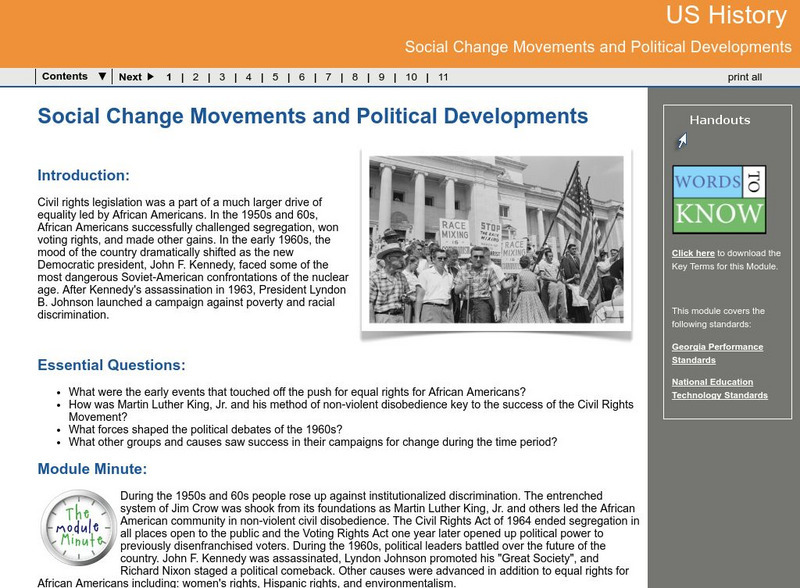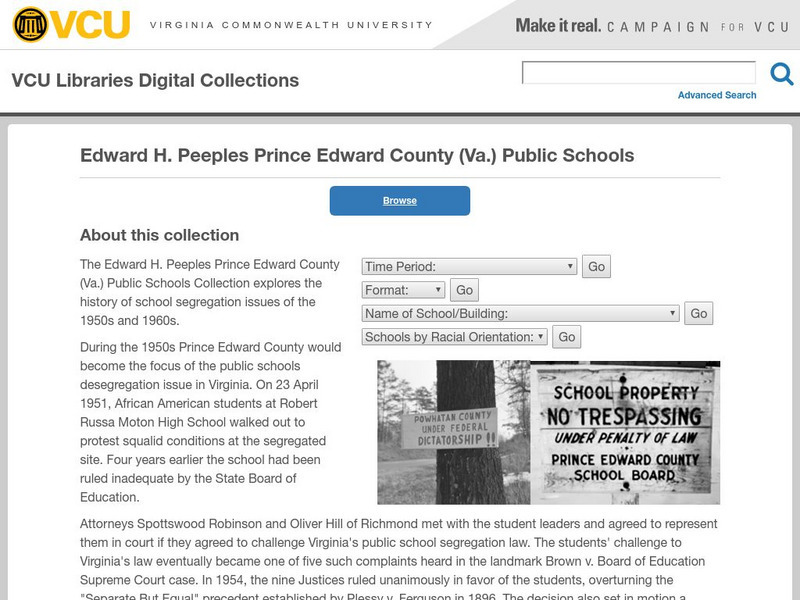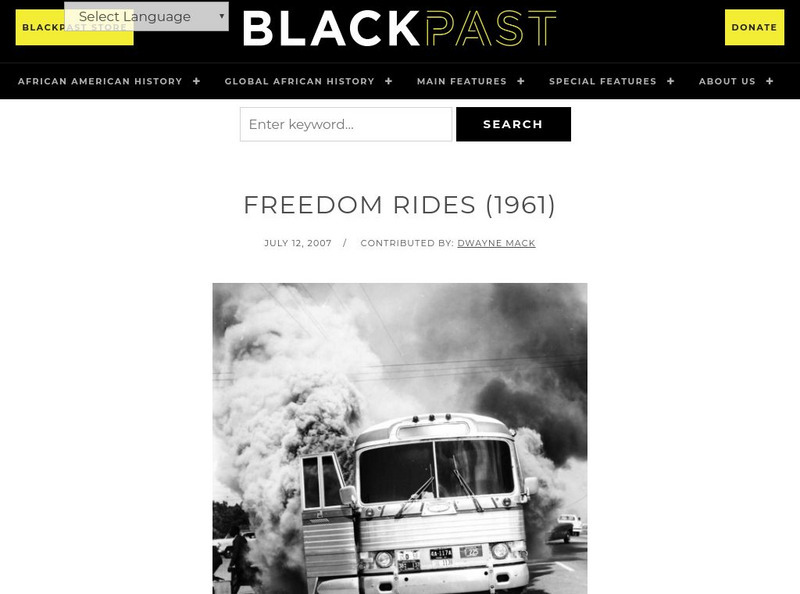PBS
Wnet: Thirteen: The Rise and Fall of Jim Crow: Barbara Johns
The amazing story of Barbara Johns, the 16-year-old who called a strike and walk out to protest the overcrowding of Robert Russa Moton High School.
Georgia Department of Education
Ga Virtual Learning: Us History Social Change Movements & Political Developments
Learning module on movements for social change and civil rights and the political developments surrounding them. Comprhensive multi-media materials and links to supplemental resources.
Smithsonian Institution
National Portrait Gallery: Black List Project: Barbara Harris
Civil rights activist Reverend Barbara Harris is featured for her involvement in freedom rides and marches in the 1960's.
Curated OER
History Matters: "And We Shall Overcome": Johnson's Special Message to Congress
Read President Lyndon B. Johnson's speech before the the Congress in support of the Voting Rights Act. Feel the passion in his address and his desire to further racial equality.
Other
Finding Dulcina: Strom Thurmond Ends Longest Filibuster in Senate History
Read about Senator Strom Thurmond's epic filibuster in an attempt to forestall the passage of the Civil Rights Act of 1957. There is a brief biography of Thurmond and his political life, as well as information about the use of the...
Country Studies US
Country Studies: The Women's Movement
Taking its cue from the Civil Rights movement, the Women's Movement gained momentum throughout the 1960s and 1970s.
Constitutional Rights Foundation
Constitutional Rights Foundation: Social Protests
Article with questions for writing and discussion on the social protests of the Civil Rights Movement. Students analyze the strengths and weaknesses of various strategies used during the 50s and 60s to challenge segregation and improve...
Black Past
Black Past: Abernathy, Ralph
In this encyclopedia entry you can read a brief account of Ralph Abernathy's part in the civil rights movement. There is a link to a website for more information.
Independence Hall Association
U.s. History: Rosa Parks and the Montgomery Bus Boycott
Rosa Parks started a revolution by refusing to give up her seat on a bus. Read about the Montgomery bus boycott, and see how the nonviolent actions of supporters of the Civil Rights movement succeeded in using the boycott to inspire more...
Digital History
Digital History: Eisenhower and Civil Rights
Like other U.S. presidents before and after him, Dwight D. Eisenhower was only proactive in instituting civil rights in a very limited way, such as ending segregation in the District of Columbia, including the federal government, and any...
National Humanities Center
National Humanities Center: Toolbox Library: Making of African American Identity: Volume Iii: Community
Series of 10 primary resources explores African American identity from 1917 to 1968, examining the changing notions of identity and affects on the definition of African American community.
Virginia Commonwealth University
Virginia Commonwealth University: Separate but Not Equal
Telling pictures of elementary schools for Blacks and Whites during the 50s and 60s. Discusses the situation in Prince Edward County that led to the Davis v. County School Board of Prince Edward County court case.
Stanford University
Stanford University: Lesson Plan on the Children's Crusade
A well designed four part lesson plan that examines the use of children in the civil rights demonstration that occurred in Birmingham under the leadership of Dr. King.
Other
Kodak: Powerful Days in White and Black
Stunning black and white photos documenting the civil rights struggle in the 1960s.
Black Past
Black Past: Freedom Rides (1961)
This encyclopedia article gives an interesting account of the Freedom Rides of 1961, which sparked later civil rights movements.
Other
Ar Net: Hispanic Americans, an Under Represented Group
An excellent description of the problems facing the involvement of Hispanic-Americans in American politics. The essay covers 1948 to 1996, with a good discussion of the civil rights era.
Other
Civil Rights Movement 1955 1965: Mississippi & Freedom Summer
Take a look at Mississippi in the early 1960s to understand why the focus of African American voter registration targeted that state. Read about the organization and implementation of the Mississippi Summer Project in 1964. See also the...
Digital History
Digital History: Simple Justice
Follow the civil rights quest for integrated schools from the beginning in 1849 through the 1954 Supreme Court decision in Brown v. the Topeka Board of Education and the struggle that ensued for decades following in the most reluctant...
Siteseen
Siteseen: American Historama: Racial Segregation History in the United States
This article contains numerous facts about black segregation history in the United States from the Civil War through the end of the Civil Rights Movement.
Other
Hsi: March on Frankfort: Who Will Go Down in History?
This site has students identify with the people of the civil rights movement. Oral histories are provided, along with a newspaper article. After reviewing the material, students are to draw a conclusion.
Khan Academy
Khan Academy: "Massive Resistance" and the Little Rock Nine
Read about the famous civil rights protest in Little Rock, Kansas in 1957 when nine African American students attempted to enter Central High School on the first day of school. Despite the presence of federal troops at the school for the...
Curated OER
National Park Service: International Civil Rights Walk of Fame: Thurgood Marshall
This is an informative biography discussing the role Thurgood Marshall had in the Civil Rights Movement, particularly as a U.S. Supreme Court Justice.
Other
Historical Marker Database: Mc Crory's Civil Rights Sit Ins Friendship Nine
Historical sign marks the building where the Friendship Nine refused to leave the McCrory's lunch counter. Short history is provided along with related websites. This group was the first to refuse bail and thus began the Jail No Bail...
Country Studies US
Country Studies: The Native American Movement
This web-article discusses how Native American activism was inspired not only by the civil rights movements in the US but also by nationalistic movements in Third World countries.





















